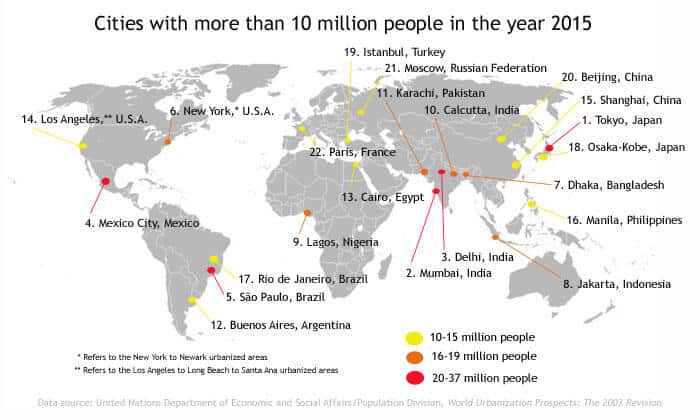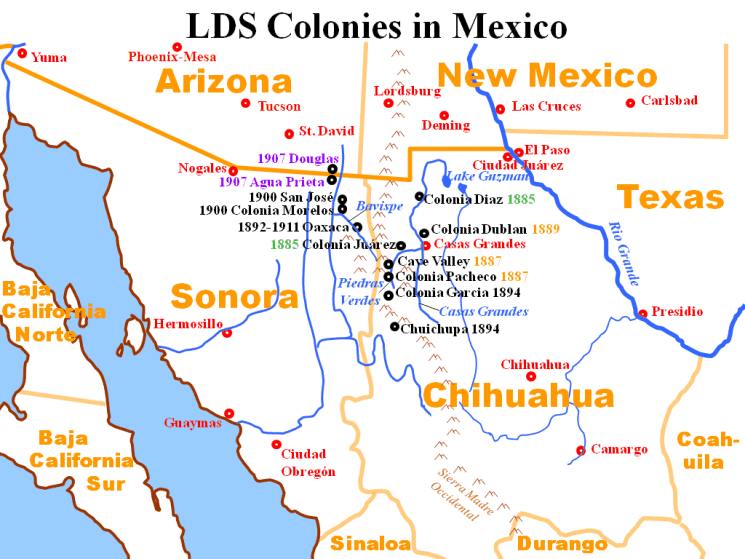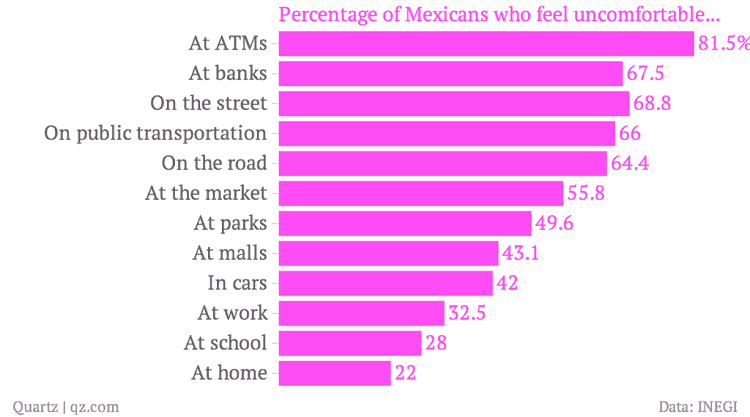Submit a Fact
Mexico City Is the 6th Largest City in the World
When it comes to Mexico City facts, there is no denying that the capital of Mexico is one huge place, with a population of over 21 million in its metropolitan area. There are many ways used to measure the size of cities, but rated in terms of this figure, Mexico City is the 6th largest in the world, and the largest metropolitan area in the western hemisphere. The city consists of 16 boroughs, and is located in the central Valley of Mexico, in the highland plateau region at an altitude of 7380 ft.
Mexico City Is Also Known as México D. F., or D. F
For those of us in the English speaking world, it seems natural to discuss Mexico City facts. But, for its majority of Spanish-speaking residents, the city is more generally known as México, D. F., or just D.F., which stands for distrito federal, the federal district. This is because, although there are 31 states in Mexico, the city is considered to be a separate federal entity. Mexico City is the center of political, financial and cultural power in the country.
Mexico City Was Founded by the Aztecs
There are many intriguing Mexico City facts regarding the original founding of a settlement on this site. The earliest incarnation of Mexico City was in 1325, when the Mexica people, now known as the Aztecs, built the city of Tenochtitlán on an island in the center of a Valley of Mexico lake system. It was also connected to the small city state Tlatelolco. The city was ingeniously designed, with causeways connecting it to the mainland, and bridges which allowed canoes to pass. These bridges could be removed at will, in order to defend the city. Within the main urban area there were also a series of canals and waterways. Tenochtitlán became the capital of the Aztec Empire until it was captured by the Spanish in 1521. These unique Mexico City facts make it the oldest capital in the Americas, and also one of only two to have been founded by Native Americans (Ecuador’s capital Quito being the other).
“Tenochtitlán” Was Renamed “Mexico” Because It Was Easier to Say
During the conquest of Tenochtitlán, much of the original city was destroyed. Within a decade or so, however, the new Spanish rulers had built the city up again. They preserved its basic layout, but built over the original Aztec temples with Catholic churches, and took over the imperial palace. They decided to call the city by its alternative name, and in 1585 the settlement became officially known as Mexico City (Ciudad de México). This, reportedly, was in part because the new name was much easier to pronounce! As the Spanish colonial empire in South and Central America developed, Mexico City became the center of a large part of it. Its current form as a federal district came in 1824, when independence from Spain was achieved.
President Porfirio Díaz Modernized the City
Mexico’s longest serving President, Porfirio Díaz, was in control for 35 years. During this period he made a great number of changes within the country’s capital, and there are numerous Mexico City facts regarding these developments. Díaz longed for his city to rival the great European capitals, and developed what would later be known as Porfirian Architecture, namely an architectural fusion of Amerindian elements with the Parisian style he so admired. During his rule many colonial buildings were therefore destroyed to make way for new buildings. The city’s resources were also expanded outwards, so that more rural zones gained access to sewage, gas and electric facilities. Hospitals, factories and schools were also built in this time, along with some of the city’s most famous landmarks.
The Metropolitan Cathedral Is the Largest in Latin America
By recent estimates, 82.7 % of the Mexican population are believed to be Catholic, so it is hardly surprising that a list of Mexico City facts includes details of an important and awe-inspiring cathedral. The Metropolitan Cathedral of the Assumption of Mary of Mexico is the largest cathedral in Latin America. The cathedral is built on the former Aztec sacred precinct in the city’s downtown area. The cathedral was a gradual project, which began with the original church built on the site after the Spanish conquest. Between 1573 and 1813, parts of the cathedral were added, until eventually the Spanish church was replaced altogether.
Mexico City Is Home to the World Famous “National Museum of Anthropology
Mexico City has been an important center of cultural and artistic work for many centuries. The city contains many famous museums, none more so than the National Museum of Anthropology (Museo Nacional de Antropología). Established in 1964, the museum is the most visited in the country, and displays artefacts relating to an impressive array of Mexico City facts. The museum is home to many relics from the city’s ancient past, including the Aztec Stone of the Sun and the statue of Xochipilli, who in Aztec mythology was the god of beauty, dance, flowers, song and games.
Along with this landmark institution, there are many other museums and galleries in the city that are must-see destinations for visitors, including the Museum of Modern Art (Museo de Arte Moderno), the Museo Soumaya which holds a fine private art collection, and the new Museum of Remembrance and Tolerance (Museo de la Memoria y Tolerancia), which commemorates the victims of atrocities and genocides around the world.
The Templo Mayor Has Existed since 1325
One of the major Mexico City facts relates to an ancient temple in the city’s center. The Templo Mayor, or Great Temple, was begun by the Aztecs in 1325, though it was rebuilt another six times throughout its history. The temple was dedicated to the Huitzilopochtli, God of War, and Tlaloc, God of Rain and Agriculture. It featured shrines to both at the top of a pyramid, and is also said to commemorate the exact spot where the latter god told the Mexica people that they had reached their promised land.
After the Spanish Conquest, however, the temple was taken apart and built over, and was lost for centuries beneath colonial buildings. The Templo Mayor was rediscovered in the 20th century, though at first there was little public interest in it. In 1987, another of Mexico City’s famed museums was established, the The Museum of the Templo Mayor (Museo del Templo Mayor). Today, it houses the major archaeological discoveries from this important Aztec site.
There Are 8.4 Murders per 100,000 People in Mexico City
Sadly, there are various troubling Mexico City facts relating to crime statistics. Mexico is at the heart of a great deal of drug-trafficking operations, as heroin, cocaine and marijuana are transported covertly into the United States. The crime organizations and cartels who participate in this traffic are the source of violent crime all across Mexico. Indeed, in a 2013 study, Mexican cities accounted for 9 of the top 50 cities in the world by murder rate. Mexico City facts indicate that in the capital, the murder rate is approximately 8.4 in every 100,000 people. Between 2009 and 2011, measures were instigated to try to curb the high crime rates in Mexico City. Initiatives included a significant expansion of the police force, and the installation of 11,000 new security cameras in the city.
Tourism Is on the Rise in Mexico City
Though Mexico City facts relating to crime might intimidate some, the general consensus is that safe and enjoyable travel to Mexico City is perfectly possible. Indeed, Mexico has a booming tourist industry, with 2014 figures suggesting that the number of international tourists for the year exceeded 14.2 million. There are many attractions to draw both domestic and foreign tourists to Mexico City, including Aztec ruins, museums and galleries, concert halls, palaces and parks.
More than 4 Million People Use the Mexico City Metro Each Day
There are many interesting Mexico City facts regarding the city’s transport system. The metro, for example, has the most extensive network of any in Latin America, serving 195 stations. Indeed, even taking into account the entire North American continent it is second in size only to the New York City Subway. The Mexico City metro is also the cheapest in the world, and offers free transport to the elderly, disabled, and those under the age of 5. While the metro is subsequently extremely popular, the very richest inhabitants of Mexico City have developed another means to get around − they use helicopters, and increasing numbers of important buildings are constructing helicopter pads to accommodate this trend.
Mexico City Contains the 20th Best Restaurant in the World
No collection of Mexico City facts would be complete without a mention of the city’s famous cuisine. In particular, Mexican foodies know there is one place in town not to be missed − Pujol in the Polanco neighborhood of Mexico City. The eatery is widely regarded to be the best restaurant in the country and was even voted as the 20th best in the world in a recent poll. Pujol is the brainchild of Mexican chef Enrique Olvera, whose menu aims to recreate historic cooking techniques and dishes while also experimenting with new forms. Typical starters at Pujol might include charred baby corn cobs, dipped in coffee mayonnaise and chicatana ants. The use of dried insects and worms is a common feature of the menu.
Mexico City Is a Great Place to Set a Record
There are a number of Mexico City facts relating to the city’s place in the record books. Perhaps it is because the population is so large − the city certainly does not lack numbers of people with which to set a new Guinness World Record! Instances of record breaking behavior in Mexico City include the creation of the world’s biggest enchilada, which weighed in at almost 1.5 tons. Then there was the record for the most people simultaneously kissing, with 39,879 participants, and the most people dancing to Michael Jackson’s song “Thriller” at once, with 13,597. More recently, the city also witnessed the largest parade of classic cars in the world, with 1,674 vehicles in action.
Mexico City Is Sinking 4 Inches Each Year
Since the ancient settlement of Tenochtitlán was built on a lake, it is perhaps not the most surprising of Mexico City facts that this was not the ideal foundation for an urban area. It has been calculated that the city is sinking at a rate of four inches (10 cm) annually. A government analysis of Mexico City facts suggested that the city has sunk 32.8 feet (10 meters) in the last 60 years. Looking for proof? In the Metropolitan Cathedral there are sloping floors and a swinging pendulum which indicate the building’s increasing tilt as it sinks.
Same-sex Marriage Is Legal in Mexico City
One of the more surprising Mexico City facts is the recent change in attitude towards gay and lesbian people. Given the prevalence of Catholic beliefs among the Mexican population, views towards homosexuality have generally been conservative. However, since 2010 same-sex marriage has been legal in the city, as is same-sex adoption. Mexico City has even begun to market itself as a gay-friendly destination in terms of tourism, and recently opened an office dedicated to this tourism angle, with city officials cutting a rainbow ribbon to inaugurate the work of the office. When the first same-sex couple in Latin America married in 2010, they were offered an all-expenses paid honeymoon in Mexico City.
The Beat Poets Loved Mexico City
There are many Mexico City facts relating to its famous foreign residents. The American writer Jack Kerouac spent a great deal of time in the city, and it was here that he wrote his extended jazz poem, Mexico City Blues. Another Beat author from the USA, William S. Burroughs, was part of more tragic events during his time in the city. Burroughs came to Mexico with his wife and children to avoid detention in the US for forging a narcotics prescription. The family settled in Mexico City and Burroughs took courses in Spanish at the City College. But, in 1951, he shot his wife, allegedly by accident during a drunken party game. She died, but he and his brother were able to bribe Mexican officials into releasing Burroughs, and he returned for a time to the USA.
Mexico City Is Home to the 3rd Richest Man in the World
There are many astonishing Mexico City facts relating to Carlos Slim, the resident who for several years was classed as the richest man in the world. As of 2014, he is considered the 3rd richest after Bill Gates and Warren Buffet. However, there is no denying Carlos Slim’s fortune − he and his family are worth an estimated $69.5 billion. Slim runs telecommunications companies, and many of his institutions and businesses are centered in Mexico City. Slim’s company Telcel, for example, control around 70% of Mexico’s wireless network. If you are in Mexico City, chances are you’ll be engaging in one of Slim’s businesses in some way.
Gabriel García Márquez Settled in Mexico City
In the Latin American world, one literary figure stands out among all the rest −
Gabriel García Márquez, known affectionately throughout the region as “Gabo”. Márquez put Latin American fiction on the map with novels such as A Thousand Years of Solitude and Love in the Time of Cholera. This Nobel Prize winning author was Colombian, but chose to eventually settle with his family in Mexico City. It was here that he died in 2014, and his family continue to live and work in the city.
A Hospital in the City “Eats Smog”
Mexico City facts reveal that, due to its location in a valley, and the high levels of traffic, the urban area has long had a smog problem. Anecdotally, it is said that children in the city often draw the sky as gray instead of blue. But all that will hopefully change with a number of recent initiatives aimed at cutting down smog in the city. The most bizarre and intriguing of these is located on the tower of the Manuel Gea Gonzalez Hospital. Here, a facade of special tiles have been added which react with pollutants when the sun hits them, and break down contamination in the air. According to the hospital, this neutralizes the equivalent of 1,000 cars’ emissions every day!
Mexico City Facts – Facts about Mexico City Summary
 Mexico City is the capital of the United Mexican States. It is one of the largest cities in the world, with a population of over 21 million in its metropolitan area. Mexico City is an important cultural, financial and political center, both nationally and globally. The original settlement was an Aztec city built on a lake system in the Valley of Mexico. After the Spanish Conquest, Mexico City began to develop, and work is still being done to uncover the Aztec ruins in the city and its surroundings. Mexico City is known for its Metropolitan Cathedral, which is the largest in Latin America. There are also many fine museums, art galleries, restaurants and concert halls.
Mexico City is the capital of the United Mexican States. It is one of the largest cities in the world, with a population of over 21 million in its metropolitan area. Mexico City is an important cultural, financial and political center, both nationally and globally. The original settlement was an Aztec city built on a lake system in the Valley of Mexico. After the Spanish Conquest, Mexico City began to develop, and work is still being done to uncover the Aztec ruins in the city and its surroundings. Mexico City is known for its Metropolitan Cathedral, which is the largest in Latin America. There are also many fine museums, art galleries, restaurants and concert halls.
Mexico City Facts




No comments:
Post a Comment